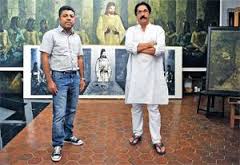The father-son duo may not share the same calling, but are not averse to sharing notes on their respective artistic pursuits
It was going to be different. This meeting. Artist Yusuf Arakkal, famous for his all-black attire as he is for his intense paintings, was dressed in pristine white kurta pyjama. “Don’t I look good?” he asks, leading the way to his large studio bathed in white light from huge north-facing windows. Paintings worth colossal amounts of money are stacked against the wall — some still await the maestro’s final touch.
Shibu, Arakkal’s only child, walks up to one of Arakkal’s paintings — an unnamed abstract — and wipes away a disturbing speck of dust. He then stands back and looks — not at the painting, but at the spot that he’s just cleaned. “I had no interest in art,” he says.
Arakkal cuts in: “In fact, I was worried that he would become an artist. I didn’t want him to be one. He would’ve been subjected to unfair comparisons.” There’s a reason behind Arakkal’s fear.
It was 1983. Arakkal was bestowed the National Award in Delhi along with Shamshad Husain, son of the legendary MF Husain. “After receiving the award,” recalls Arakkal, “we were walking back together when we overheard an artist say, ‘Baap ka beta hai isliye award le gaya.’ (He is THE father’s son, that’s why he took the award). That was terribly unfair to Shamshad.”
Arakkal never wanted Shibu to be subjected to such derision. He needn’t have worried.
Shibu’s calling was different. He wanted to become a photographer, but he didn’t know it at that time. Back then he wanted to be a football player, cricket player and also “an IAF pilot”.
He was a curious child, remembers the father. When he was two-years-old Shibu ripped off the film from his father’s Praktica camera and declared: “There is nothing to see.” Arakkal laughs, remembering the incident.
When he was in the eighth standard, Shibu was enamored by his father’s photographer friend, Regis Richard’s tiny camera. “It was almost like a spy camera,” recalls Shibu. He bombarded Richard with questions. And before he left the city, Richard gifted Shibu his Asahi Pentax 110 camera. “It was my first camera. Ever,” says Shibu.
However, Arakkal was convinced about his son’s talent as a photographer only when he saw a photo of a tiger clicked by him for an inter-college competition. “I looked at it and knew at once that this boy understood lighting,” says Arakkal, whose paintings are renowned for their artistic show of light and shadows. Shibu won the competition for the next three years in a row. “He had begun his journey that led him down an arduous route reserved for artists,” explains Arakkal.
The Arakkals discuss their works with each other freely. Shibu’s panoramic work from his series Passing By occupy pride of place at the Arakkal’s home. Jostling for attention is his baby portrait done by Arakkal during an eclipse when a four-year-old Shibu was more inclined to peer at the sun. “It was a way to keep him indoors and still by asking him to pose for me,” says Arakkal.
The duo might not agree on many things in life, but they firmly believe that to be an artist one has to have in-depth technical knowledge. As an art student at the Chitrakala Parishad College, Arakkal remembers his teachers sending them out “into the world to do live sketching” — 50 sketches a week and 10 watercolour paintings were the norm. The first thing he did after graduating in 1973 was to destroy most of his works done as a student. “I didn’t want to be burdened by those works and wanted to start afresh,” he says.
He then painted eight paintings — and several collages and collographs — depicting abstract and religious themes — and had his first solo show at the Alliance Francaise in 1975. It was a sell-out. “Today, students regularly hold solo shows even while learning art. There is a big hurry,” feels Arakkal. Shibu says the same is true of his world. “Half of the photographers have not seen a dark room and many do not understand the depth of photography.”
Father and son share the creative realm but their approach to it is different. “I am not emotional like him,” says Shibu. That could be because their early, impressionable years were diverse. Arakkal, from the royal Arakkal family in Kerala, had run away from home at 16. He wanted to be an artist. For two years he roamed the streets of Bangalore — unwilling to let go of his dream. “If I am an artist today, it is because I was stubborn about my dream,” says Arakkal. “He is the most stubborn person in our family,” laughs Shibu. His two-year-old daughter Zarah, he says, displays her grandfather’s stubborn streak. “Probably taking after him,” he says.
When Shibu recently won the Florence Biennale Gold Medal (2013) for his Constructing Life, Arakkal’s heart swelled with fatherly pride. The son had made a place for himself under the sun, away from his father’s colossal shadows. But there were detractors. Some of them commented that Shibu got the award because his father had influenced the jury. “Dad wanted to clarify but I told him not to,” says Shibu. “I rather focus on my work than answering them.” Arakkal nods in agreement. His son has indeed charted his own path.
source: http://www.bangaloremirror.com / Bangalore Mirror / Home> Columns> Sunday Read / by Jayanthi Madhukar, Bangalore Mirror Bureau / April 12th, 2014









